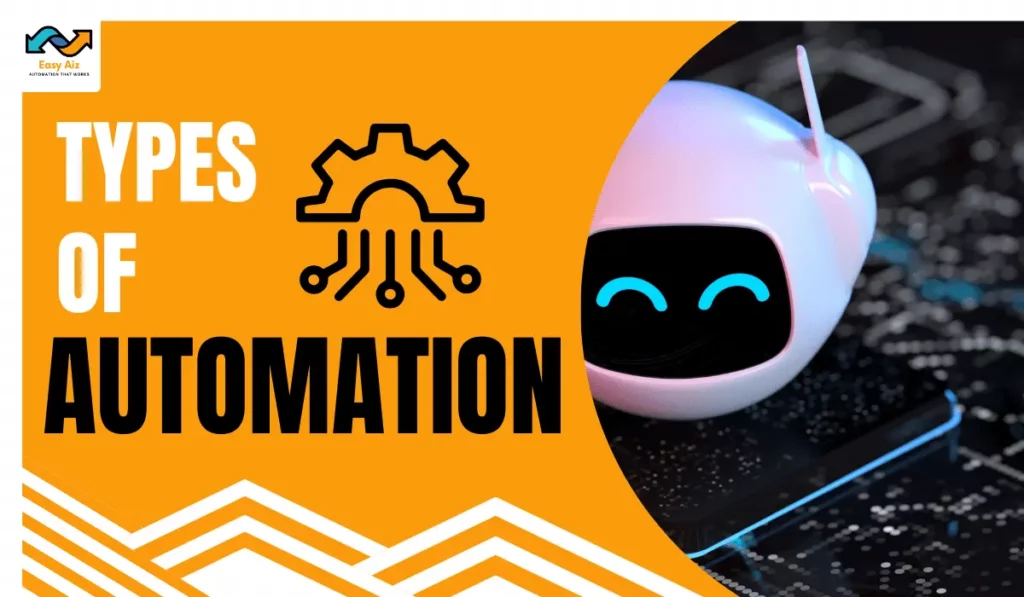Table of Contents
ToggleWhat Is Automation: Today’s Business Need
Key Takeaways
- Automation is the process of how the system works automatically; it is the powerful force that is bringing changes to the business’s productivity and sales.
- Automation has multiple benefits: increasing efficiency and productivity, improving accuracy and quality, reducing cost, increasing safety and working 24/7.
- There are different types of automation, such as fixed automation, programmable automation, flexible automation, robotic automation, industrial automation, process and home automation, and more. It depends on your needs and which automation you need.
- Zapier, Make, IFTTT, Airflow, and Workato are the top automation tools, and their unique features come with various utilizations and benefits. These tools come with various automation needs and continue to revolutionize the world.
The word “Automation” has increased in usage across various businesses and conversations in the current era. It is not just a trendy phrase; it is a powerful force changing how we live, work, and interact with technology. We’ll go into the exciting field of Automation, exploring what Automation is, how it works, and why it’s a game-changer in the modern landscape.
It is necessary to first have some understanding of Automation before diving into the ocean.
What is Automation?
Automation is applying technology to activities with the least amount of human participation. It may automate various jobs, from easy repetition to complex decision-making.
Its primary goals are to increase productivity, decrease human error, and free up valuable human resources so they may work on more imaginative and strategic projects.

Advantages of Automation
-
- Increased efficiency and productivity: Automated tasks may be completed significantly more quickly and efficiently than manual operations. It allows employees to focus on advanced and strategic work.
-
- Improved accuracy and quality: Automated tasks are less prone to errors than manual tasks. This can lead to improved product quality and customer satisfaction.
-
- Reduced costs: It can reduce labour costs and other operational expenses.
-
- Increased safety: It can be used to perform dangerous tasks for humans.
-
- 24/7 Operations: Its systems do not require breaks or shifts; they may operate continuously, allowing for round-the-clock operations. This is especially important in industries like manufacturing and data processing, where continuous output is essential.
Automation can be a powerful tool to improve efficiency, productivity, and quality of life. However, it is necessary to implement it carefully and thoughtfully.
Case Studies: Real-Life Examples of Automation in Action
Businesses across various industries have adopted automation as a cornerstone of efficiency and productivity. Let’s look at some real-life case studies that showcase the transformative power of automation:
E-commerce Order Fulfillment Optimization
A small e-commerce startup faced a challenge in keeping up with the influx of orders, and manual processing needed to be more manageable. By integrating automated order fulfillment systems, including inventory management, shipping label generation, and customer notification, the company was able to streamline its operations significantly. As a result, order processing time was reduced by 50%, improving customer satisfaction and increasing sales.
Healthcare Appointment Scheduling
A busy medical clinic faced appointment scheduling and patient management challenges. The clinic could optimize appointment slots, reduce no-shows, and improve patient flow by implementing automated scheduling software integrated with its electronic health records system. This resulted in more efficient use of staff resources, reduced patient wait times, and improved patient outcomes.
Manufacturing Process Optimization
A manufacturing company sought to improve efficiency and reduce production errors in its assembly line processes. By deploying robotic automation systems for repetitive tasks such as component assembly and quality inspection, the company significantly reduced defects and production downtime. The implementation of automation not only improved product quality but also enhanced worker safety by minimizing exposure to hazardous tasks.
These case studies show how automation can improve operational efficiency, customer satisfaction, and overall business performance. By leveraging automation technologies based on their specific needs, businesses can achieve new levels of productivity and competitiveness in today’s marketplace.
Practical Strategies for Successful Automation Implementation
The journey with automation can be daunting for businesses, but with careful planning and execution, it can generate significant rewards. Here are some practical tips to provide successful automation implementation:
Define Clear Objectives
Clearly define your objectives and goals before diving into automation. Identify key pain points or inefficiencies in your processes that automation can address and establish measurable metrics to track success.
Start Small
Begin with small-scale automation initiatives to test the waters and validate the feasibility of automation in your organization. This allows for iterative improvements and adjustments before scaling up.
Involve Stakeholders
Engage organizational stakeholders in the automation planning and implementation process, including frontline workers, managers, IT professionals, and senior leadership. Their input and buy-in are necessary for successful adoption and integration.
Invest in Training
Provide comprehensive training and support to employees who will be involved in using and maintaining automated systems. Ensure they have the necessary skills and knowledge to maximize the benefits of automation and troubleshoot any issues that may arise.
Monitor and Evaluate
Continuously monitor the performance of automated systems and collect data to evaluate their impact on key business metrics. Be prepared to iterate and refine your automation strategies based on feedback and insights gathered from ongoing monitoring and evaluation efforts.
By following these implementation tips, businesses can navigate the complexities of automation adoption more effectively and maximize the value of their automation investments. With careful planning, thoughtful execution, and ongoing optimization, automation can become a powerful tool for driving innovation and growth in today’s competitive business landscape.

Top 10 Types of Automation
Automation can take many forms and is classified into various types based on application, complexity, and scope. Here are some of the common types of Automation:
Fixed Automation
This is also known as “hard Automation,” which relies on using specialized gear precisely developed to perform a specific and specialized array of tasks. It is commonly used in industries where the production process remains constant and doesn’t require frequent reprogramming or adjustment.
Programmable Automation
It is more flexible than fixed Automation. It involves machines or systems that can be easily reconfigured or reprogrammed to adapt to changes in the production process. This type of Automation is well-suited for tasks that may need occasional adjustment or retooling.
Flexible Automation
Flexible automation systems are designed to handle various tasks and adapt to different workloads and product specifications. You often spot this automation in industries with loads of different products or always changing production needs.
Robotic Automation
Robots with sensors and cameras do it all. From pick-and-place to mind-boggling manufacturing, they’re the real deal.
Industrial Automation
This covers various automation systems and technologies used in manufacturing and industrial settings. It’s all about making things move:
PLC for control, CNC for precision, and SCADA for monitoring.
Process Automation
It focuses on controlling and optimizing sequential or continuous processes. It is widely used in industries such as chemical manufacturing, oil and gas production, and food processing, where precise control and monitoring are essential.
Home Automation
Picture this: your crib transformed with gadgets and gizmos running the show! Smart devices are bossing around your place, from the lights and thermostat to the security and the party vibes. It allows homeowners to manage and automate household tasks and functions remotely through smartphones or voice-activated assistants.
Office Automation
It streamlines administrative tasks in the workplace. It includes email, document management systems, workflow computerization, and office communication tools to enhance efficiency and productivity.
Digital Marketing Automation
Digital marketing automation tools and software help businesses automate various aspects of their online marketing efforts. This includes email marketing, social media posting, lead nurturing, and data analytics to optimize marketing campaigns.
Test Automation
Testing with a twist! We’re talking about test automation, which uses nifty software and clever scripts to make software testing a breeze. This high-tech wizardry not only speeds up testing but also increases precision while eliminating those annoying human errors in quality checks.
Many types of Automation are used in different industries and applications. For example, there is for home and building control, for transportation, and healthcare.
How does Automation work?
The way Automation works depends on the task or process is automated and the technology used, but there are common principles and components in most computerization systems:
-
- Input
Automation begins with data or information collection. Sources can include sensors, manual data entry, or external systems.
- Input
-
- Control System
A central control system or software manages the automation process. It receives input, processes data, and issues commands to the relevant components.
- Control System
-
- Sensors and Actuators
Sensors monitor the system or environment. Actuators perform physical actions in response.
Example: In smart home automation, a thermostat uses temperature sensors and a heating system as an actuator.
- Sensors and Actuators
-
- Decision-Making Logic
Automation systems incorporate decision-making logic. It crunches data, follows set rules, and decides. Advanced mechanization may use machine learning and AI for complex decision-making.
- Decision-Making Logic
-
- Feedback Loop
Many systems include feedback loops to maintain correct operation. When things go off track, we fix them up.
- Feedback Loop
-
- Communication
Automation systems often communicate with other systems or humans. Methods include APIs, email alerts, or user interfaces.
- Communication
-
- Execution
The control system issues commands to actuators for specific actions.
Example: In industrial Automation, robotic arms perform manufacturing tasks as instructed.
- Execution
-
- Monitoring and Reporting
Systems have monitoring and reporting components. These track system statuses and provide performance information for issue identification and optimization.
- Monitoring and Reporting
-
- Safety Measures
Safety measures are incorporated, especially in industrial applications. Examples include sensors on industrial robots to prevent collisions with humans.
- Safety Measures
-
- Integration
Automation systems may need to integrate with other systems and devices. This involves using standardized protocols or APIs to exchange data and commands.
- Integration

Top 5 Automation Tools: Today’s Choice
-
- Zapier
Meet this awesome automation wizard! Zapier Links 7,000+ apps, no code needed. User-friendly, craft Zaps effortlessly. - Make ( Integromat )
Make Formerly Integromat is a no-code wonderland where 1,500+ apps and services hold hands and dance to your tune, no coding required. You’re the boss, making custom workflows your way. - IFTTT
IFTTT is a simple automation app that allows users to create simple workflows called “applets” to connect apps and services. - Airflow
Airflow is a cloud-based workflow management platform that is designed for data engineers and data scientists. - Workato
Meet Workato, the cloud wizard linking your apps. It whips up slick integrations for seamless business automation.
You’ve probably heard about these awesome tools. They’re big players in the game and come packed with features for businesses of every size.
Easy Aiz - Automation That Works
See how EasyAiz Automates your Business!
Get Quality Services for growing your business, 700+ companies have worked with us and saved thousands of hours and your company could be the next.
Schedule a Free Consultation planning that suits your business.
Book A Free CallTop 5 Automation Testing Tools
- Katalon
Katalon Studio is a testing automation tool designed for web, mobile, and API testing. It offers a user-friendly interface and supports scripting in Groovy and Java. It also provides features for test case design, execution, and reporting. - Test Complete
Introducing Test Complete, your ultimate testing wizard! It excels in web, desktop, mobile, and API tests. It offers a record-and-playback feature and scripting in languages like JavaScript, Python, and VBScript. - Selenium
Imagine Selenium as your trusty sidekick for web application testing. It’s like having a versatile toolkit that speaks the language of various programming superheroes. Plus, with the Selenium WebDriver, you’re all set to command web browsers effortlessly. It’s like having a magic wand in the digital realm. - Cypress
Cypress is an open-source end-to-end testing framework primarily designed for web applications. It gives you real-time updates, time-travel debugging, and a user-friendly API. - Appium
It’s your open-source buddy for testing Android and iOS apps. Appium handles native, hybrid, and mobile web apps with ease. Widely adopted for mobile testing, it’s multilingual and ready for action.
These tools serve various automation testing needs, including web, mobile, and API testing. Your choice among them should depend on your specific testing requirements, application platforms, and the level of expertise with the chosen tool.
Conclusion:
Automation has the power to transform industries and bring evolution to the way you work and live. It is more than a technological trend; from its historical roots to its diverse applications in different industries, It continues to revolutionize the world. Embracing Automation is the key to a more efficient, error-free, and cost-effective future.
FAQs
No, Automation has been around for centuries, with its roots dating back to ancient civilizations.
Automation in healthcare enhances patient care, reduces errors, and streamlines administrative tasks.
Automation in manufacturing means speedier production and top-notch quality via robotic assembly lines.
AI will play a pivotal role in Automation, enabling machines to learn and adapt, making them smarter and more capable.
You can start by checking out home automation for a brighter, easier daily life.




